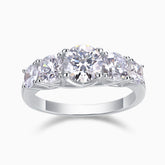Eco-Friendly Beauty: Moissanite vs. Lab-Grown Diamonds
In recent years, the jewelry industry has seen a shift toward more sustainable and ethical options. Moissanite and lab-grown diamonds have become popular alternatives to mined diamonds, offering beauty, durability, and eco-friendliness. While both gemstones share similarities, they are distinct in composition, appearance, and cost. In this article, we’ll explore the key differences between Moissanite and lab-grown diamonds, highlighting their advantages and benefits.
What is Moissanite?
Moissanite is a gemstone made from silicon carbide, first discovered in 1893 by French chemist Henri Moissan. Though it occurs naturally in very small amounts, Moissanite is now mainly produced in labs. Known for its brilliant sparkle, it has a higher refractive index than diamonds, which means it reflects more light and displays intense brilliance. Moissanite is not a diamond, but its striking visual appeal makes it a popular choice for engagement rings and fine jewelry.
What is a Lab-Grown Diamond?
A lab-grown diamond is a real diamond created in a laboratory using high-tech processes like High Pressure High Temperature (HPHT) or Chemical Vapor Deposition (CVD). These diamonds are composed of pure carbon and have the same crystal structure, hardness, and brilliance as mined diamonds. The key difference is that lab-grown diamonds are created in weeks, while natural diamonds take millions of years to form.

Key Differences
-
Composition & Origin
- Moissanite is made from silicon carbide, while lab-grown diamonds are pure carbon.
- Lab-grown diamonds are identical to natural diamonds in every way, but Moissanite is a distinct mineral.
-
Appearance
- Moissanite’s higher refractive index gives it a more brilliant sparkle than diamonds, which some find even more dazzling.
- Lab-grown diamonds offer the same sparkle as natural diamonds, with a more subtle brilliance compared to Moissanite.
-
Durability
- Moissanite is extremely durable, ranking 9.25 on the Mohs hardness scale, just below diamonds (which score a perfect 10).
- Lab-grown diamonds are as durable as natural diamonds, perfect for everyday wear.
-
Cost
- Moissanite is much more affordable than lab-grown diamonds, offering similar visual appeal at a lower price point.
- Lab-grown diamonds are less expensive than natural diamonds but still cost more than Moissanite.
-
Environmental Impact
- Both Moissanite and lab-grown diamonds are eco-friendly options. Moissanite’s production doesn’t involve mining, and lab-grown diamonds have a much smaller carbon footprint than mined diamonds.
Why Choose Moissanite or Lab-Grown Diamonds?
Both Moissanite and lab-grown diamonds offer exceptional value for those seeking sustainable, high-quality gemstones.
- Moissanite is ideal for customers looking for brilliant, budget-friendly jewelry without compromising on beauty or durability.
- Lab-grown diamonds are perfect for those who want a “real” diamond without the ethical and environmental issues associated with mining.
Conclusion
Whether you choose Moissanite for its incredible brilliance and affordability or a lab-grown diamond for its authenticity and eco-friendly nature, both options are beautiful, durable, and sustainable. By choosing these alternatives, you’re making a conscious decision to reduce environmental impact while still enjoying timeless, stunning jewelry.
Which gemstone resonates with you more—Moissanite or lab-grown diamonds? Let us know in the comments!






